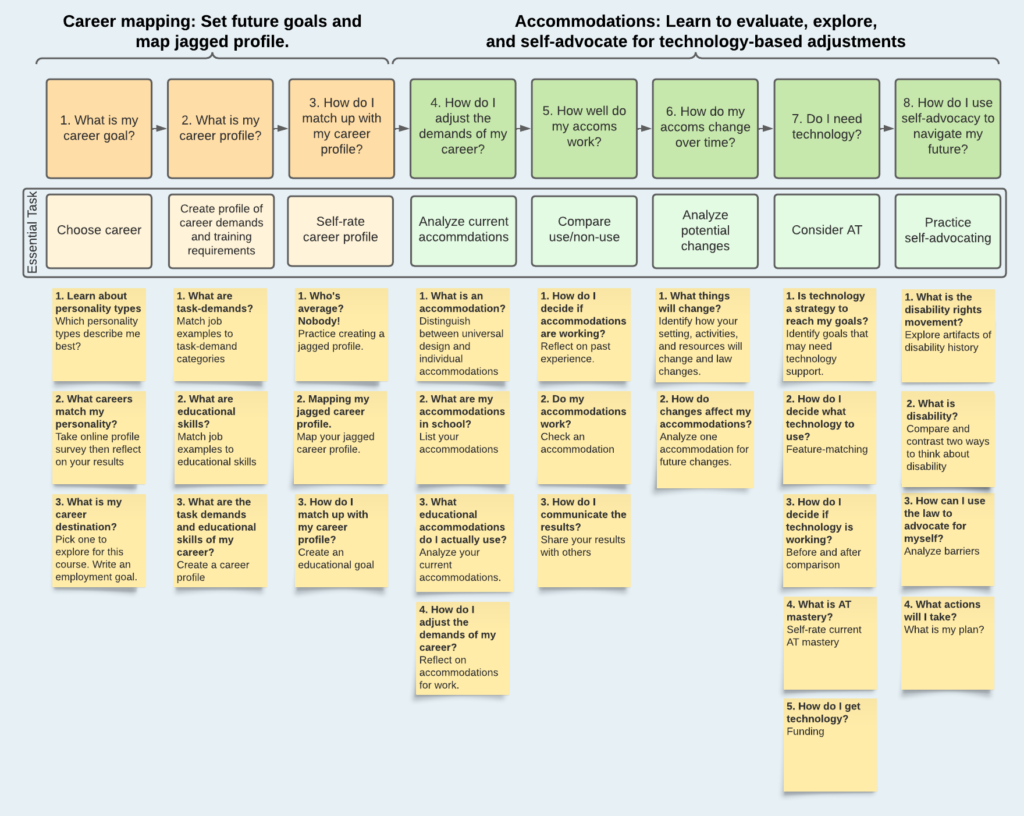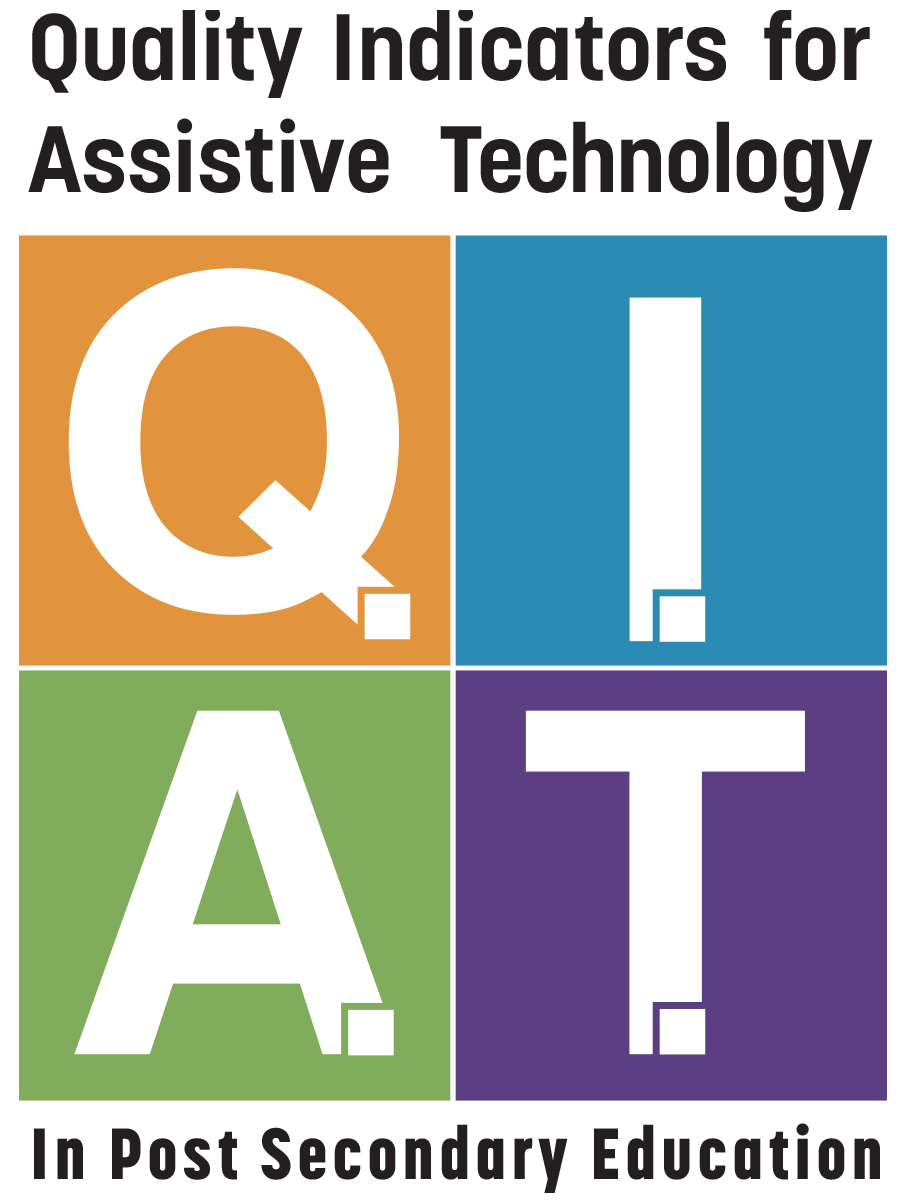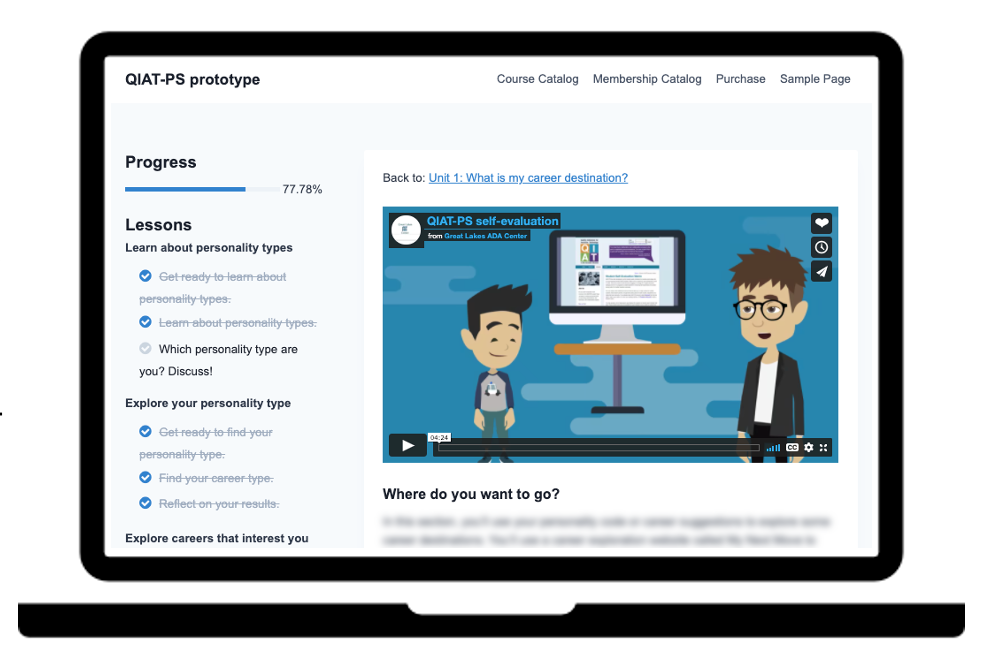New curriculum in development!
Self-Determination and Assistive Technology
Vision
Empower young people with disabilities to achieve their personal goals.
Mission
Prepare secondary students with disabilities to understand the purpose, selection, acquisition, and use of accommodations (including assistive technology devices) and advocate for their legal right to accommodations (including assistive technology) in postsecondary settings.
Target audience
Students with disabilities (IEPs or 504 plans) in junior or senior year or school-district provided transition programming who plan to attend a traditional 4 year college, a traditional 2-year community college, 4-year college with structured support programs, fee-for-service college program for students with disabilities, bridge program to college, college alternative programs (TPSID), vocational trade/certification programs, or students who plan to work competitively in an environment that requires a significant amount of onboarding, job orientation and ongoing training.
Long-term outcomes:
- Increase the self-efficacy of high school and transition students with disabilities to use accommodations (including assistive technology) to achieve their academic and career goals
- Increase the self-evaluation skills of high school and transition students with disabilities to determine the effectiveness of their accommodations (including technology) across different activities and environments
- Increase self-advocacy skills of high school and transition students with disabilities for accommodation needs and rights (including assistive technology) across environments and systems
Short-term outcomes
- Increase student’s ability to determine academic and career goals and personal learning profile
- Increase student’s ability to identify how well their accommodations (including AT) are working
- Increase student’s ability to explain how changes affect accommodations (including AT)
- Increase student’s ability to decide what technology to use
- Increase student’s understanding of how rights laws apply to them
- Increase student’s ability to articulate a clear sense of goals and how they are affect by accommodations (including AT).
Learning targets
- Define my academic/career goals
- Identify skills needed to achieve my academic/career goals
- Compare/contrast goals profile with my profile (i.e., create jagged profile)
- Identify my current accommodations and analyze their purpose
- Evaluate whether my accommodations are working for me
- Determine how my need for accommodations can change
- Apply steps to figure out what additional accommodations/AT might help me, now or in the future
- Communicate my need to use accommodations (including AT) to a variety of people
Curriculum outline
- Designed for K12 seniors and transition students
- Eight units based on career planning and self-advocacy (the following draft outline is subject to change)
- Unit 1: What is my career destination?
- Learn about personality types
- What careers match my personality?
- What is my career destination?
- Unit 2: What is my career profile?
- What are task demands?
- What are educational skills?
- What are the task demands and educational skills of my career destination?
- Unit 3: How do I match up with my career profile?
- Who’s average? Nobody!
- Mapping my jagged career profile
- How do I match up with my career profile?
- Unit 4: How do I adjust the demands of my career?
- What is an accommodation?
- What are my accommodations in school?
- What educational accommodations do I use?
- How do I adjust the demands of my career?
- Unit 5: How well do my accommodations work?
- How do I decide if accommodations are working?
- Do my accommodations work?
- How do I communicate the results?
- Unit 6: How do my accommodations change over time?
- What things will change?
- How do changes affect my accommodations?
- Unit 7: Can technology help me reach my goals?
- How do I decide what technology to use?
- How do I decide if technology is working?
- What is AT mastery?
- How do I get technology?
- Unit 8: How do I use self-advocacy to navigate my future?
- What is the disability rights movement?
- How do people think about disability and identity?
- How can I use the law to advocate for myself?
- What actions will I take?
- Unit 1: What is my career destination?
Delivery mechanism
- Web-based learning management system
- Self-paced with parent or teacher guide
- Portfolio-based learning activities
- Free access through federal ADA grant
How can I get involved?
- Provide expert review of the content
- Participate in pilot studies
- We are currently looking for participants to pilot the prototype curriculum during the upcoming academic year (2024-2025)
- Participate in an orientation training (recorded or live)
- Work through the curriculum with one student in the target range (high school senior or 18-21 year old in K12 transition program)
- Mostly text-only content. Videos are still under development.
- Deliver curriculum as direct instruction during prototype pilot for maximum feedback.
- Report in-depth feedback from the student about their perspective on the lessons and their understanding of the content. The student has the opportunity to contribute to content development!
- We are currently looking for participants to pilot the prototype curriculum during the upcoming academic year (2024-2025)
Sign up using this Google Form!
Questions? Email Dan Cochrane, QIAT-PS project director
Research
The curriculum is based on recent research on Quality Indicators for Assistive Technology in Postsecondary Education.
Gould, R., Heider, A., Parker Harris, S., Jones, R., Peters, J., Eisenberg, Y., and Caldwell, K. (2022). Self-Determination and Quality Indicators for Assistive Technology in Postsecondary Education. Journal of Postsecondary Education and Disability. 35(1). 45-80.
Curriculum map
A curriculum map was created by a team of assistive technology and transition experts.

Curriculum map image description
Flowchart style curriculum map. Units 1-3 Career mapping: Set future goals and map jagged profile. Units 4-8 Accommodations: Learn to evaluate, explore, and self-advocate for technology-based adjustments.
Unit 1: What is my career goal? Essential task: Choose career. 1: Learn about personality types. Which personality types describe me best? 2: What careers match my personality? Take online profile survey then reflect on your results. 3: What is my career destination? Pick one to explore for this course. Write an employment goal.
Unit 2: What is my career profile? Essential task: Create profile of career demands and training requirements. 1: What are task-demands? Practice matching job examples to task demand categories. 2. What are educational skills? Match job examples to educational skills. 3. What are the task demands and educational skills of my career? Create a career profile.
Unit 3: How do I match up with my career profile? Essential task: Self-rate career profile. 1. Who’s average? Nobody! Practice creating a jagged profile. 2. Mapping my jagged career profile. map your jagged career profile. 3. How do I match up with my career profile? Create an educational goal.
Unit 4: How do I adjust the demands of my career? Essential task: Analyze current accommodations. 1. What is an accommodation? Distinguish between universal design and individual accommodations. 2. What are my accommodations? List your accommodations. 3. What educational accommodations do I actually use? Analyze your current accommodations. 4. How do I adjust the demands of my career? Reflect on accommodations for work.
Unit 5: How well to my accommodations work? Essential task: Compare use vs non-use. 1. How do I decide if accommodations are working? Reflect on past experience. 2. Do my accommodations work? Check an accommodation. 3. How do I communicate the results? Share your results with others.
Unit 6: How do my accommodations change over time? Essential task: Analyze potential changes. 1. What things will change? Identify how your setting, activities, and resources will change and law changes. 2. How do changes affect my accommodations? Analyze one accommodation.
Unit 7: Do I need technology? Essential task: Consider AT. 1. Is technology a strategy to reach my goals? 2. How do I decide what technology to use? 3. How do I decide if technology is working? Before and after comparison. 4. What is AT mastery? 5. How do I get technology? Funding.
Unit 8: How do I use self-advocacy to navigate my future? Essential task: Practice self-advocating. 1. What is the disability rights movement? 2. What is disability? 3. How can I use the law to advocate for myself? 4. What actions will I take?

